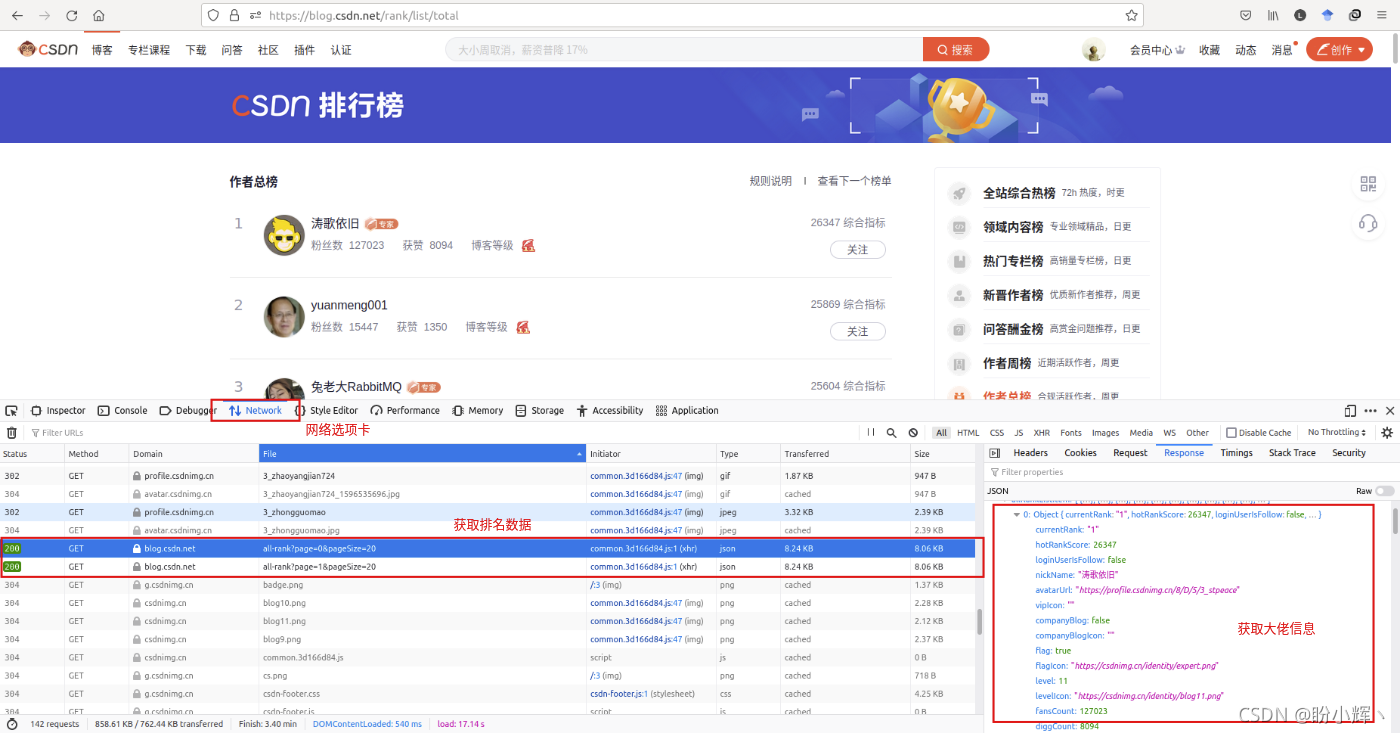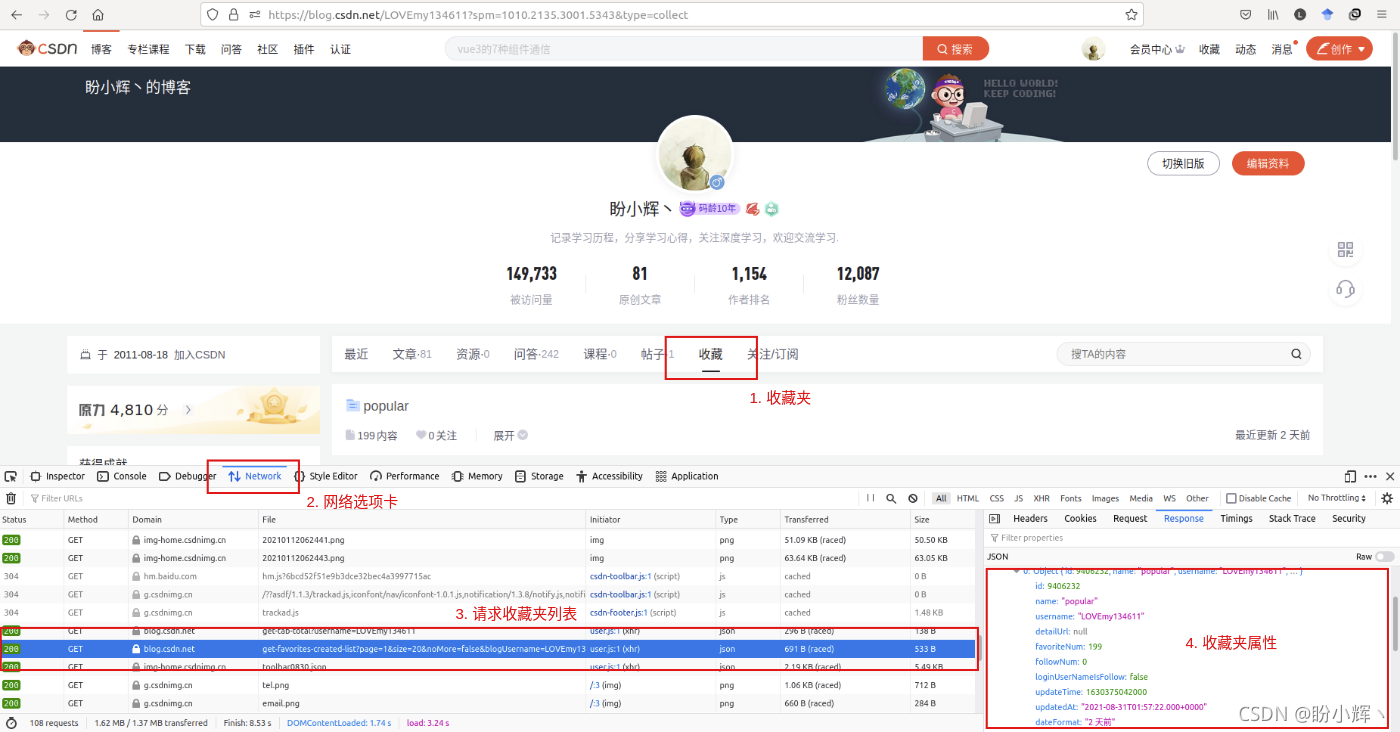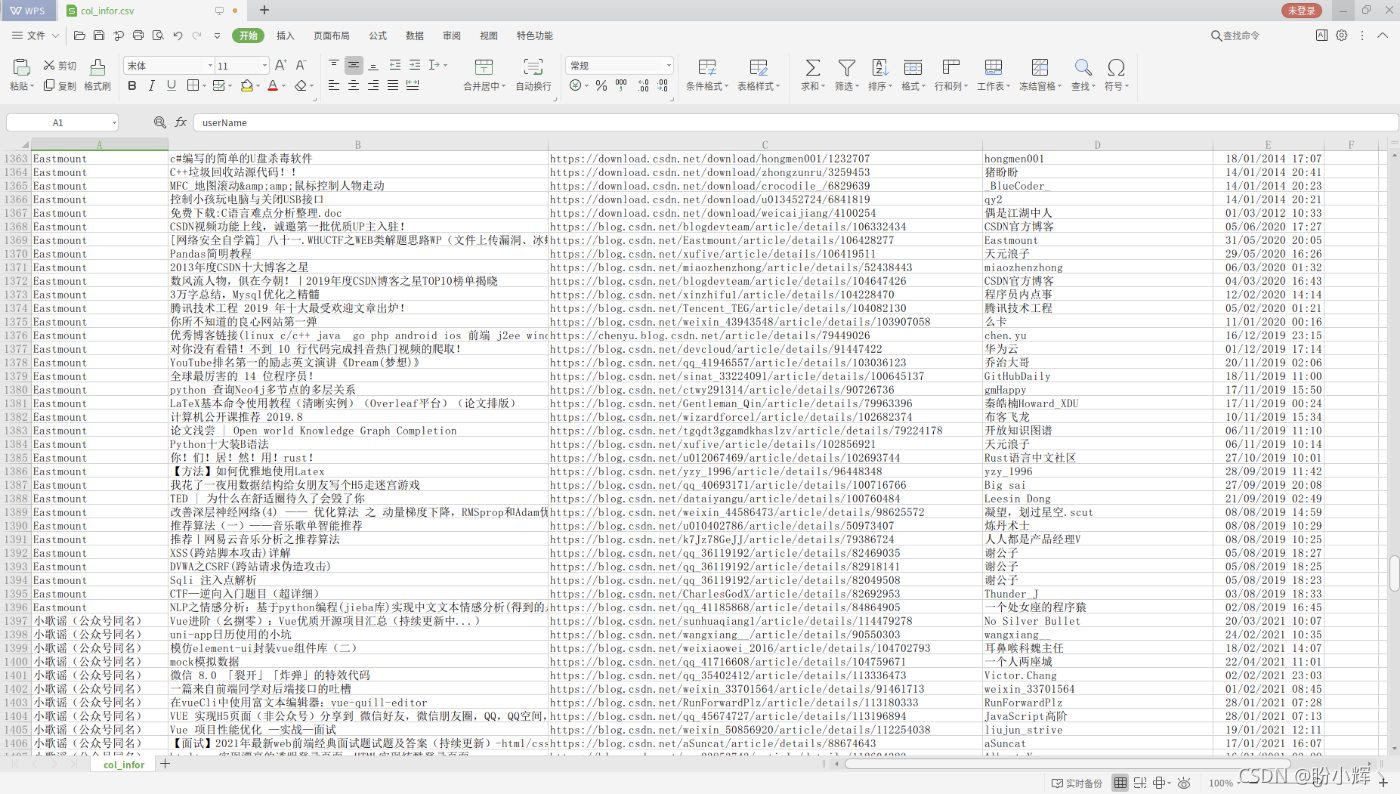目录
- Python爬虫分析
- 一、程序说明
- 二、数据爬取
- 1、获取 CSDN 作者总榜数据
- 2、获取收藏夹列表
- 3、获取收藏数据
- 4、爬虫程序完整代码
- 5、爬取数据结果
- 三、数据分析及可视化
Python爬虫分析
前言:
计算机行业的发展太快了,有时候几天不学习,就被时代所抛弃了,因此对于我们程序员而言,最重要的就是要时刻紧跟业界动态变化,学习新的技术,但是很多时候我们又不知道学什么好,万一学的新技术并不会被广泛使用,太小众了对学习工作也帮助不大,这时候我们就想要知道大佬们都在学什么了,跟着大佬学习走弯路的概率就小很多了。现在就让我们看看C站大佬们平时都收藏了什么,大佬学什么跟着大佬的脚步就好了!
一、程序说明
通过爬取 “CSDN” 获取全站排名靠前的博主的公开收藏夹,写入 csv 文件中,根据所获取数据分析领域大佬们的学习趋势,并通过可视化的方式进行展示。
二、数据爬取
使用 requests 库请求网页信息,使用 BeautifulSoup4 和 json 库解析网页。
1、获取 CSDN 作者总榜数据
首先,我们需要获取 CSDN 中在榜的大佬,获取他/她们的相关信息。由于数据是动态加载的 (因此使用开发者工具,在网络选项卡中可以找到请求的 JSON 数据:

观察请求链接:
https://blog.csdn.net/phoenix/web/blog/all-rank?page=0pageSize=20
https://blog.csdn.net/phoenix/web/blog/all-rank?page=1pageSize=20
...
可以发现每次请求 JSON 数据时,会获取20个数据,为了获取排名前100的大佬数据,使用如下方式构造请求:
url_rank_pattern = "https://blog.csdn.net/phoenix/web/blog/all-rank?page={}pageSize=20"
for i in range(5):
url = url_rank_pattern.format(i)
#声明网页编码方式
response = requests.get(url=url, headers=headers)
response.encoding = 'utf-8'
response.raise_for_status()
soup = BeautifulSoup(response.text, 'html.parser')
请求得到 Json 数据后,使用 json 模块解析数据(当然也可以使用 re 模块,根据自己的喜好选择就好了),获取用户信息,从需求上讲,这里仅需要用户 userName,因此仅解析 userName 信息,也可以根据需求获取其他信息:
userNames = []
information = json.loads(str(soup))
for j in information['data']['allRankListItem']:
# 获取id信息
userNames.append(j['userName'])
2、获取收藏夹列表
获取到大佬的 userName 信息后,通过主页来观察收藏夹列表的请求方式,本文以自己的主页为例(给自己推广一波),分析方法与上一步类似,在主页中切换到“收藏”选项卡,同样利用开发者工具的网络选项卡:

观察请求收藏夹列表的地址:
https://blog.csdn.net/community/home-api/v1/get-favorites-created-list?page=1size=20noMore=falseblogUsername=LOVEmy134611
可以看到这里我们上一步获取的 userName 就用上了,可以通过替换 blogUsername 的值来获取列表中大佬的收藏夹列表,同样当收藏夹数量大于20时,可以通过修改 page 值来获取所有收藏夹列表:
collections = "https://blog.csdn.net/community/home-api/v1/get-favorites-created-list?page=1size=20noMore=falseblogUsername={}"
for userName in userNames:
url = collections.format(userName)
#声明网页编码方式
response = requests.get(url=url, headers=headers)
response.encoding = 'utf-8'
response.raise_for_status()
soup = BeautifulSoup(response.text, 'html.parser')
请求得到 Json 数据后,使用 json 模块解析数据,获取收藏夹信息,从需求上讲,这里仅需要收藏夹 id,因此仅解析 id 信息,也可以根据需求获取其他信息(例如可以获取关注人数等信息,找到最受欢迎的收藏夹):
file_id_list = []
information = json.loads(str(soup))
# 获取收藏夹总数
collection_number = information['data']['total']
# 获取收藏夹id
for j in information['data']['list']:
file_id_list.append(j['id'])
这里大家可能会问,现在 CSDN 不是有新旧两种主页么,请求方式能一样么?答案是:不一样,在浏览器端进行访问时,旧版本使用了不同的请求接口,但是我们同样可以使用新版本的请求方式来进行获取,因此就不必区分新、旧版本的请求接口了,获取收藏数据时情况也是一样的。
3、获取收藏数据
最后,单击收藏夹展开按钮,就可以看到收藏夹中的内容了,然后同样利用开发者工具的网络选项卡进行分析:

观察请求收藏夹的地址:
https://blog.csdn.net/community/home-api/v1/get-favorites-item-list?blogUsername=LOVEmy134611folderId=9406232page=1pageSize=200
可以看到刚刚获取的用户 userName 和收藏夹 id 就可以构造请求获取收藏夹中的收藏信息了:
file_url = "https://blog.csdn.net/community/home-api/v1/get-favorites-item-list?blogUsername={}folderId={}page=1pageSize=200"
for file_id in file_id_list:
url = file_url.format(userName,file_id)
#声明网页编码方式
response = requests.get(url=url, headers=headers)
response.encoding = 'utf-8'
response.raise_for_status()
soup = BeautifulSoup(response.text, 'html.parser')
最后用 re 模块解析:
user = user_dict[userName]
user = preprocess(user)
# 标题
title_list = analysis(r'"title":"(.*?)",', str(soup))
# 链接
url_list = analysis(r'"url":"(.*?)"', str(soup))
# 作者
nickname_list = analysis(r'"nickname":"(.*?)",', str(soup))
# 收藏日期
date_list = analysis(r'"dateTime":"(.*?)",', str(soup))
for i in range(len(title_list)):
title = preprocess(title_list[i])
url = preprocess(url_list[i])
nickname = preprocess(nickname_list[i])
date = preprocess(date_list[i])
4、爬虫程序完整代码
import time
import requests
from bs4 import BeautifulSoup
import os
import json
import re
import csv
if not os.path.exists("col_infor.csv"):
#创建存储csv文件存储数据
file = open('col_infor.csv', "w", encoding="utf-8-sig",newline='')
csv_head = csv.writer(file)
#表头
header = ['userName','title','url','anthor','date']
csv_head.writerow(header)
file.close()
headers = {
'User-Agent':'Mozilla/5.0 (Windows NT 6.1; WOW64) AppleWebKit/537.36 (KHTML, like Gecko) Chrome/63.0.3239.132 Safari/537.36'
}
def preprocess(string):
return string.replace(',',' ')
url_rank_pattern = "https://blog.csdn.net/phoenix/web/blog/all-rank?page={}pageSize=20"
userNames = []
user_dict = {}
for i in range(5):
url = url_rank_pattern.format(i)
#声明网页编码方式
response = requests.get(url=url, headers=headers)
response.encoding = 'utf-8'
response.raise_for_status()
soup = BeautifulSoup(response.text, 'html.parser')
information = json.loads(str(soup))
for j in information['data']['allRankListItem']:
# 获取id信息
userNames.append(j['userName'])
user_dict[j['userName']] = j['nickName']
def get_col_list(page,userName):
collections = "https://blog.csdn.net/community/home-api/v1/get-favorites-created-list?page={}size=20noMore=falseblogUsername={}"
url = collections.format(page,userName)
#声明网页编码方式
response = requests.get(url=url, headers=headers)
response.encoding = 'utf-8'
response.raise_for_status()
soup = BeautifulSoup(response.text, 'html.parser')
information = json.loads(str(soup))
return information
def analysis(item,results):
pattern = re.compile(item, re.I|re.M)
result_list = pattern.findall(results)
return result_list
def get_col(userName, file_id, col_page):
file_url = "https://blog.csdn.net/community/home-api/v1/get-favorites-item-list?blogUsername={}folderId={}page={}pageSize=200"
url = file_url.format(userName,file_id, col_page)
#声明网页编码方式
response = requests.get(url=url, headers=headers)
response.encoding = 'utf-8'
response.raise_for_status()
soup = BeautifulSoup(response.text, 'html.parser')
user = user_dict[userName]
user = preprocess(user)
# 标题
title_list = analysis(r'"title":"(.*?)",', str(soup))
# 链接
url_list = analysis(r'"url":"(.*?)"', str(soup))
# 作者
nickname_list = analysis(r'"nickname":"(.*?)",', str(soup))
# 收藏日期
date_list = analysis(r'"dateTime":"(.*?)",', str(soup))
for i in range(len(title_list)):
title = preprocess(title_list[i])
url = preprocess(url_list[i])
nickname = preprocess(nickname_list[i])
date = preprocess(date_list[i])
if title and url and nickname and date:
with open('col_infor.csv', 'a+', encoding='utf-8-sig') as f:
f.write(user + ',' + title + ',' + url + ',' + nickname + ',' + date + '\n')
return information
for userName in userNames:
page = 1
file_id_list = []
information = get_col_list(page, userName)
# 获取收藏夹总数
collection_number = information['data']['total']
# 获取收藏夹id
for j in information['data']['list']:
file_id_list.append(j['id'])
while collection_number > 20:
page = page + 1
collection_number = collection_number - 20
information = get_col_list(page, userName)
# 获取收藏夹id
for j in information['data']['list']:
file_id_list.append(j['id'])
collection_number = 0
# 获取收藏信息
for file_id in file_id_list:
col_page = 1
information = get_col(userName, file_id, col_page)
number_col = information['data']['total']
while number_col > 200:
col_page = col_page + 1
number_col = number_col - 200
get_col(userName, file_id, col_page)
number_col = 0
5、爬取数据结果
展示部分爬取结果:

三、数据分析及可视化
最后使用 wordcloud 库,绘制词云展示大佬收藏。
from os import path
from PIL import Image
import matplotlib.pyplot as plt
import jieba
from wordcloud import WordCloud, STOPWORDS
import pandas as pd
import matplotlib.ticker as ticker
import numpy as np
import math
import re
df = pd.read_csv('col_infor.csv', encoding='utf-8-sig',usecols=['userName','title','url','anthor','date'])
place_array = df['title'].values
place_list = ','.join(place_array)
with open('text.txt','a+') as f:
f.writelines(place_list)
###当前文件路径
d = path.dirname(__file__)
# Read the whole text.
file = open(path.join(d, 'text.txt')).read()
##进行分词
#停用词
stopwords = ["的","与","和","建议","收藏","使用","了","实现","我","中","你","在","之"]
text_split = jieba.cut(file) # 未去掉停用词的分词结果 list类型
#去掉停用词的分词结果 list类型
text_split_no = []
for word in text_split:
if word not in stopwords:
text_split_no.append(word)
#print(text_split_no)
text =' '.join(text_split_no)
#背景图片
picture_mask = np.array(Image.open(path.join(d, "path.jpg")))
stopwords = set(STOPWORDS)
stopwords.add("said")
wc = WordCloud(
#设置字体,指定字体路径
font_path=r'C:\Windows\Fonts\simsun.ttc',
# font_path=r'/usr/share/fonts/wps-office/simsun.ttc',
background_color="white",
max_words=2000,
mask=picture_mask,
stopwords=stopwords)
# 生成词云
wc.generate(text)
# 存储图片
wc.to_file(path.join(d, "result.jpg"))
到此这篇关于Python爬虫分析汇总的文章就介绍到这了,更多相关Python爬虫内容请搜索脚本之家以前的文章或继续浏览下面的相关文章希望大家以后多多支持脚本之家!
您可能感兴趣的文章:- 关于python爬虫应用urllib库作用分析
- python爬虫Scrapy框架:媒体管道原理学习分析
- python爬虫Mitmproxy安装使用学习笔记
- Python爬虫和反爬技术过程详解
- python爬虫之Appium爬取手机App数据及模拟用户手势
- 爬虫Python验证码识别入门
- Python爬虫技术
- Python爬虫爬取商品失败处理方法
- Python获取江苏疫情实时数据及爬虫分析
- Python爬虫之Scrapy环境搭建案例教程
- Python爬虫中urllib3与urllib的区别是什么
- 教你如何利用python3爬虫爬取漫画岛-非人哉漫画